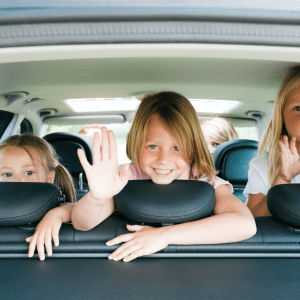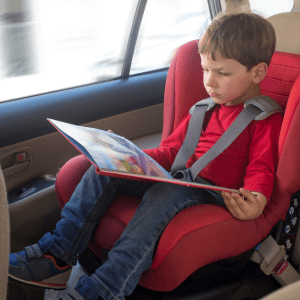As parents or caregivers, ensuring our children’s safety in a vehicle is a top priority. A crucial part of that safety is ensuring that seat belts are secured and remain fastened throughout the journey. Unfortunately, some passengers may try to unbuckle their seatbelts and move around the car, which can place them at risk. Not to mention the long list of unpredictable scenarios that an unbuckled passenger may encounter, it’s unsafe for the driver, other passengers in the vehicles and other drivers on the road.
In this guide, we will explore some common reasons why children may try to unbuckle their seatbelts and provide tips on how to prevent this from happening.
The Importance of Seatbelt Safety for Children
Ensuring that children are safely secured with seat belts during car rides is not just a precaution; it’s an absolute necessity. The importance of seatbelt safety for children cannot be overstated, as it is one of the most effective means to protect them in the event of a car accident. Seat belts are specifically designed to save lives and minimize injuries by keeping occupants positioned safely, reducing the risk of being thrown from the vehicle or striking the interior.
For children, who are naturally more vulnerable due to their smaller size and developing bodies, the right use of seatbelts along with appropriate car seats tailored to their age, weight, and height is crucial. It’s not only about following the law—it’s about extending a form of care that keeps them safe as they grow. Every trip can be an opportunity to teach them about the importance of buckling up, and embedding a lifelong habit of prioritizing their safety.
Common Reasons Why Kids Unbuckle Their Seat Belts
Kids unbuckling their seat belts can be a common challenge for parents, often driven by curiosity, discomfort, or a desire for independence. Young children, in particular, are natural explorers who may see the seat belt as just another boundary to test. They might unbuckle themselves to shift positions in search of comfort or simply to see what happens when they press the release button.
For some children, especially those with sensory sensitivities or special needs, the feeling of a seat belt might be uncomfortable or overwhelming. These children might try to remove their seat belts because they feel restricted or because the texture and pressure of the belt are unpleasant.
Understanding Your Child’s Behavior
Understanding your child’s behavior, especially in relation to developmental stages, is key to fostering a safer and more harmonious environment, particularly when it comes to something as crucial as car safety. As children grow, their cognitive, emotional, and physical development directly influences how they interact with the world around them. For instance, toddlers are known for their desire to touch everything as a way of exploring and learning.
This natural curiosity can sometimes lead to them unbuckling their seatbelts.
Identifying triggers for this behavior involves paying close attention to what might be prompting your child to unbuckle. Discomfort, the need for a bathroom break, or simply mimicking what they see adults do can all be factors. Some children might unbuckle their seat belts as a way to get attention, signaling that they need some form of interaction.
By observing when and why your child attempts to unbuckle, you can better address these triggers. Provide explanations suited to their level of understanding about why it’s important to stay buckled up, ensure their comfort as much as possible, and establish routines that include them in the process, like checking their own seatbelt as part of a ‘safety check’ before the car starts. This way, you turn seatbelt safety into a cooperative and positive part of every journey.
Tips for Keeping Your Kids Buckled Up
Keeping your children safe on the road means ensuring they are always buckled up properly. Here are some friendly tips to help make seatbelt use a natural part of every car ride:
- Use Age-Appropriate Car Seats and Boosters: Safety starts with the right gear. Ensure your child rides in a car seat or booster that suits their age, weight, and height. This not only boosts their safety but also their comfort during rides.
- Make Seatbelt Use a Non-Negotiable Rule: Consistency is key. Establish a clear, firm rule that the car doesn’t move until everyone’s buckled up. This helps create a routine and underscores the importance of seatbelt use.
- Positive Reinforcement and Rewards: Praise goes a long way. Acknowledge and reward your child when they buckle up without fuss. Little rewards or a sticker chart can make them look forward to getting in their seat.
- Distract and Engage Your Child During Rides: Keep books, toys, or car-friendly activities handy to ensure they stay seated and entertained. Engaging audio stories or sing-alongs also works wonders.
- Model Safe Behavior: Lead by example. Always wear your seatbelt and explain why you do so. Children are great imitators and often learn best by watching.
- Introduce ‘Buckle Boss‘: Empower them by making them the ‘Buckle Boss’—in charge of making sure everyone is buckled correctly before you drive. This not only makes them feel important but also teaches responsibility.
By incorporating these strategies, you’ll foster a positive and safe environment for your children, making every journey more enjoyable and secure.
Addressing Specific Issues
Addressing specific issues during car rides, such as motion sickness, car anxiety, and the need for special accommodations, can significantly enhance the travel experience for both children and parents. Here are some thoughtful approaches to ensure comfort and safety for everyone involved:
- Motion Sickness: Motion sickness is common in children. To help alleviate symptoms, encourage your child to look at distant objects rather than focusing on books or screens. Fresh air can also help, so crack a window if possible. Before long journeys, avoid heavy meals and consider wristbands or over-the-counter remedies if recommended by your pediatrician.
- Car Anxiety: Anxiety during car rides can be eased with comforting routines. Soft music, favorite toys, or a special ‘travel buddy’ (a stuffed animal or blanket) can provide emotional support. Discussing the journey and what to expect can also help reduce anxiety, making your child feel more secure and in control.
- Special Needs and Accommodations: Children with special needs may require additional accommodations for safe and comfortable travel. Consult with a healthcare provider to ensure your car seat and positioning meet your child’s specific requirements. Customized supports, such as seatbelt adjusters or headrests, can be implemented to enhance safety and comfort.
Dealing with Resistance and Non-Compliance
Dealing with resistance and non-compliance from children, especially when it concerns safety rules like seatbelt use, requires patience, consistency, and clear communication. It’s important to explain the necessity of safety in terms they can understand. For example, liken the seatbelt to a superhero cape that keeps them safe, making the concept both relatable and fun.
Consistency is crucial in enforcing safety rules. Children thrive on routine and clear expectations. Consistently remind them of the rules and the reasons behind them each time you get in the car. If rules are broken, calmly explain the consequences and follow through every time. This could be as simple as not starting the car until everyone is buckled up properly.
Sometimes, resistance can be persistent, and it’s okay to seek outside help. This could mean consulting with a pediatrician to ensure there isn’t a hidden discomfort or anxiety issue or working with a child psychologist who can offer strategies tailored to your child’s needs.
Secure Their Future: The Lifesaving Importance of Buckling Up Your Child
Ensuring your child remains buckled up in the car is more than just a legal requirement; it’s a fundamental aspect of safeguarding their well-being during every journey. Properly using seat belts significantly reduces the risk of injury in the event of an accident, providing vital protection that can save lives. The benefits of this simple act of securing your child cannot be overstated—it is one of the most effective measures you can take to protect them on the road.
As a parent or caregiver, prioritizing safety in the car demonstrates a commitment to your child’s health and future. It teaches them the importance of taking precautions and being responsible, lessons that will serve them well throughout life. I encourage you to consistently enforce the use of seat belts and engage in open discussions about car safety. By doing so, you are not only protecting your child but also setting a foundation of safety they will carry into adulthood.



